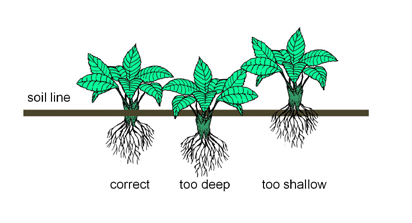Strawberries—juicy, sweet deliciousness that keeps us gardeners yearning for our favorite spring and summer months. In fact we just harvested our first ripe berries of the season over at the Petaluma Bounty, sending pint after pint home with hungry-eyed volunteers during last Saturday’s 80 degree April squelcher. At the Bounty we grow some delicious berries and coach many home gardeners on how to do the same in their gardens. Now for the Garden Club, here are our secrets!
Two options for growing strawberries: Fall Planting or Spring Planting
We choose to plant our strawberries every fall, as do many commercial growers here in California and in other high-producing, warm-winter states like Florida. We find this fall-planting method gives the plant a great big head-start for growing all winter long, and have shared this method with many happy home gardeners in Sonoma County.
This method may seem a little counter-intuitive at first. You do all this work to prepare your soil and get your plants in the ground during fall, and then have to sit there and wait for a good six months or so until you actually can harvest any berries. But, my friends, it is well worth the wait! The life cycle of the strawberry plant is such that if you get it in the ground before it’s really cold out, the roots get a chance to start growing, expanding, and feeding the plant throughout the late fall months. Then, in winter, the plant really just sits there, not resuming real growth again until the days start getting longer in early spring.
BUT when those warmer days do finally arrive, you don’t have to worry about waiting for the soil to dry down in order to plant your berries – they’re already sitting pretty in the quickly-warming soil, with thriving and active root systems. Now have better and stronger plants that are ready to start producing berries earlier than if you were to plant them in spring.
So, in summary, the benefits of planting strawberries in the fall are:
- Bigger berry size
- Higher fruit yields
- Earlier berries
- Less maintenance and water use during hot months of summer (because we are still in a drought, this is especially important for California gardeners this season!)
You’ll find that there are so many strawberry varieties to choose from. Here are some of my personal favorites:
- Albion
- Seascape
- Chandler
- Sweet Anne
Growing Strawberries with Fall Planting in 9 Steps
For a brief mention on the spring-planting method for strawberries, see the end of the post.
1) Choose a sun-filled area to either plant in the ground or in raised beds, imagining that you will need about 3 square feet of space for each plant.
2) Prepare your soil. You’ll want to do this well in advance of planting season, for every crop you grow, but in particular with such a long-lived crop like the strawberry. I recommend you plant your berries around October in Sonoma County, so starting to think about proper soil care as we approach the summer months is a great idea.
Building good soil is a long-term endeavor that demands patience and care. Whether your soil previously hosted crops, was bare ground, or covered in weeds, it’s a great idea to get some cover crop in there during the summer months. In September, or a few weeks before you want to plant the strawberries, turn in the cover crop and mix a good 3 inch layer of compost into the top 6 inches of your soil. Your berries will thank you! If you are planting into the ground and your soil is really heavy, you can create some mounded beds to help with drainage.
3) Mulch the area where the plants will grow. Black plastic is a great option because it warms the soil and keeps almost every weed from growing. To plant into the plastic, you simply pierce big holes where your plants will go. Straw mulch is another great option, and while it won’t warm the soil, it will keep some weeds at bay and help retain moisture.
4) Plant the berries. I prefer to source bare-root strawberry plants for fall-planting. This means the plants are dormant and will not start actively growing until you plant them in soil. Two of my favorite sources for bare-root strawberry are Lassen Canyon Nursery and Johnny’s Select Seeds. You can order the plants to arrive in the fall and store them in the fridge for a week or two if need be before planting time.

Choose a cool morning or evening to plant your strawberries. If going with the bare roots, you’ll want to soak them in water, or better yet a heavily diluted fish/kelp solution. This will begin to rehydrate the roots and they can sit in the liquid for a few hours. When planting, stick your trowel about 6 inches into the ground and pull toward yourself, making a hole to place the plant in. You’ll want to plant just deep enough so that plant’s crown is at the soil surface level.

5) Water them in—well. I like to water in everything overhead, either with a hose that has a gentle wand or with an oscillating sprinkler. This will help settle the soil around the plants. From there on out, it’s great if you can switch to drip irrigation to save water. In my soil, strawberries need watering about twice a week. If your soil is relatively sandy, your plants could need more water, up to almost four times a week. Remember to give a good drenching so that water trickles down to the base of the roots – about 8” under ground.
6) Feed every other week with a fish/kelp solution and/or compost tea during active growth phases – this means through November and then starting again in March. You can do this with something as simple as a watering can – and drench both the whole plant and the soil around it with the solution. Once the berries are big enough to harvest, you can stop feeding them.
7) In cases of freezing, cover with fabric. Strawberries can withstand a lot of cold weather and even a hard frost or two, but it’s best to have row fabric laid out next to them just in case. You can leave strawberries covered for a few days if need be, but it’s best to let them breathe for a night or two after being covered.
8) For bigger plants and berries, cut the runners off your strawberries as they grow, right down to the base of the runner. I come through every month or so to do this.
9) Harvest! Depending on where you are, weather patterns, and berry type you may be harvesting from April well into August, and perhaps beyond. The plants will start to taper off a bit in the late summer, and this is ok! Appreciate the early fruit and get ready for next year’s planting.
Quick tip: A June-bearing berry refers to one big flush early in the summer, while ever-bearing berries will offer a more steady supply throughout the season.
Not every home gardener will be able to employ the fall-planting method for growing strawberries. Although this really is the best method for growing strong plants, abundant fruit, and deep strong root systems that will require less water, you can definitely still plant your berry transplants in spring and enjoy some delicious fruit. All the same main principles apply regarding planting, feeding, and watering, but you can expect your plants to start producing berries soon after getting them in the ground.
In conclusion, it’s great time to start thinking about the best option for berries in your garden no matter which method you use. You can head over to your local garden center now and buy some rooted transplants to pop in the ground, or start prepping your soil for a fall planting. Or you can do both! Do you have any tips for growing strawberries that we missed? Share in the comment section below!
Next time on the blog we’ll be celebrating Compost Awareness Week by featuring a great interview with Caiti Hachmyer of Red H Farm in Sebastopol. Caiti is a great local farmer who is transitioning some of her farm to a no-till system. We’ll be chatting farming, compost, and how the two work together. Stay tuned!








 Family
Family

